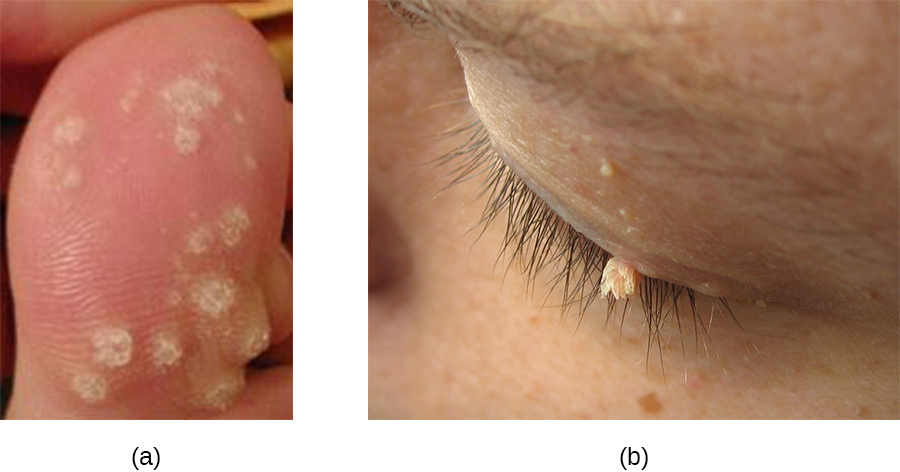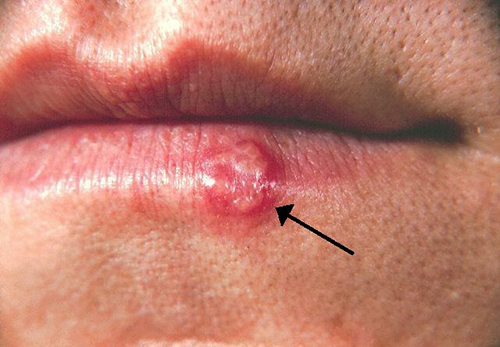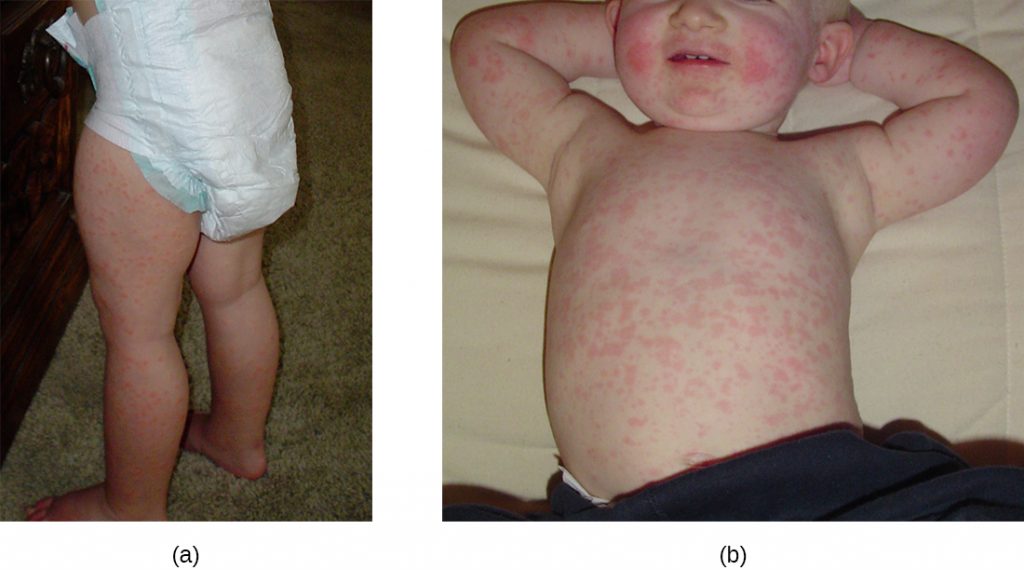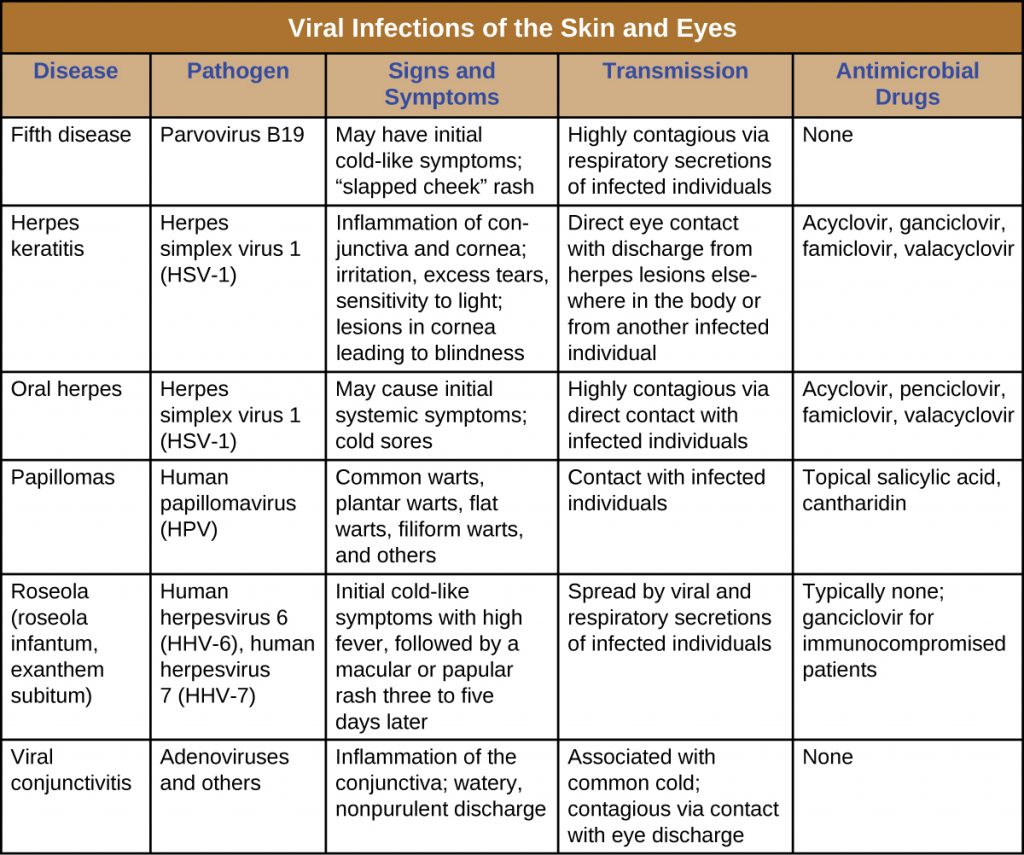22. Skin and Eye Infections
22.3 Viral Infections of the Skin and Eyes
Learning Objectives
- Identify the most common viruses associated with infections of the skin and eyes
- Compare the major characteristics of specific viral diseases affecting the skin and eyes
Until recently, it was thought that the normal microbiota of the body consisted primarily of bacteria and some fungi. However, in addition to bacteria, the skin is colonized by viruses, and recent studies suggest that Papillomaviridae, Polyomaviridae and Circoviridae also contribute to the normal skin microbiota. However, some viruses associated with skin are pathogenic, and these viruses can cause diseases with a wide variety of presentations.
Numerous types of viral infections cause rashes or lesions on the skin; however, in many cases these skin conditions result from infections that originate in other body systems. In this chapter, we will limit the discussion to viral skin infections that use the skin as a portal of entry. Later chapters will discuss viral infections such as chickenpox, measles, and rubella—diseases that cause skin rashes but invade the body through portals of entry other than the skin.
Papillomas
Papillomas (warts) are the expression of common skin infections by human papillomavirus (HPV) and are transmitted by direct contact. There are many types of HPV, and they lead to a variety of different presentations, such as common warts, plantar warts, flat warts, and filiform warts. HPV can also cause sexually-transmitted genital warts, which will be discussed in Urogenital System Infections. Vaccination is available for some strains of HPV.
Common warts tend to develop on fingers, the backs of hands, and around nails in areas with broken skin. In contrast, plantar warts (also called foot warts) develop on the sole of the foot and can grow inwards, causing pain and pressure during walking. Flat warts can develop anywhere on the body, are often numerous, and are relatively smooth and small compared with other wart types. Filiform warts are long, threadlike warts that grow quickly.
In some cases, the immune system may be strong enough to prevent warts from forming or to eradicate established warts. However, treatment of established warts is typically required. There are many available treatments for warts, and their effectiveness varies. Common warts can be frozen off with liquid nitrogen. Topical applications of salicylic acid may also be effective. Other options are electrosurgery (burning), curettage (cutting), excision, painting with cantharidin (which causes the wart to die so it can more easily be removed), laser treatments, treatment with bleomycin, chemical peels, and immunotherapy (Figure 22.23).

Oral Herpes
Another common skin virus is herpes simplex virus (HSV). HSV has historically been divided into two types, HSV-1 and HSV-2. HSV-1 is typically transmitted by direct oral contact between individuals, and is usually associated with oral herpes. HSV-2 is usually transmitted sexually and is typically associated with genital herpes. However, both HSV-1 and HSV-2 are capable of infecting any mucous membrane, and the incidence of genital HSV-1 and oral HSV-2 infections has been increasing in recent years. In this chapter, we will limit our discussion to infections caused by HSV-1; HSV-2 and genital herpes will be discussed in Urogenital System Infections.
Infection by HSV-1 commonly manifests as cold sores or fever blisters, usually on or around the lips (Figure 22.24). HSV-1 is highly contagious, with some studies suggesting that up to 65% of the US population is infected; however, many infected individuals are asymptomatic.[1] Moreover, the virus can be latent for long periods, residing in the trigeminal nerve ganglia between recurring bouts of symptoms. Recurrence can be triggered by stress or environmental conditions (systemic or affecting the skin). When lesions are present, they may blister, break open, and crust. The virus can be spread through direct contact, even when a patient is asymptomatic.
While the lips, mouth, and face are the most common sites for HSV-1 infections, lesions can spread to other areas of the body. Wrestlers and other athletes involved in contact sports may develop lesions on the neck, shoulders, and trunk. This condition is often called herpes gladiatorum. Herpes lesions that develop on the fingers are often called herpetic whitlow.
HSV-1 infections are commonly diagnosed from their appearance, although laboratory testing can confirm the diagnosis. There is no cure, but antiviral medications such as acyclovir, penciclovir, famciclovir, and valacyclovir are used to reduce symptoms and risk of transmission. Topical medications, such as creams with n-docosanol and penciclovir, can also be used to reduce symptoms such as itching, burning, and tingling.

- What are the most common sites for the appearance of herpetic lesions?
Roseola and Fifth Disease
The viral diseases roseola and fifth disease are somewhat similar in terms of their presentation, but they are caused by different viruses. Roseola, sometimes called roseola infantum or exanthem subitum (“sudden rash”), is a mild viral infection usually caused by human herpesvirus-6 (HHV-6) and occasionally by HHV-7. It is spread via direct contact with the saliva or respiratory secretions of an infected individual, often through droplet aerosols. Roseola is very common in children, with symptoms including a runny nose, a sore throat, and a cough, along with (or followed by) a high fever (39.4 ºC). About three to five days after the fever subsides, a rash may begin to appear on the chest and abdomen. The rash, which does not cause discomfort, initially forms characteristic macules that are flat or papules that are firm and slightly raised; some macules or papules may be surrounded by a white ring. The rash may eventually spread to the neck and arms, and sometimes continues to spread to the face and legs. The diagnosis is generally made based upon observation of the symptoms. However, it is possible to perform serological tests to confirm the diagnosis. While treatment may be recommended to control the fever, the disease usually resolves without treatment within a week after the fever develops. For individuals at particular risk, such as those who are immunocompromised, the antiviral medication ganciclovir may be used.
Fifth disease (also known as erythema infectiosum) is another common, highly contagious illness that causes a distinct rash that is critical to diagnosis. Fifth disease is caused by parvovirus B19, and is transmitted by contact with respiratory secretions from an infected individual. Infection is more common in children than adults. While approximately 20% of individuals will be asymptomatic during infection,[2] others will exhibit cold-like symptoms (headache, fever, and upset stomach) during the early stages when the illness is most infectious. Several days later, a distinct red facial rash appears, often called “slapped cheek” rash (Figure 22.25). Within a few days, a second rash may appear on the arms, legs, chest, back, or buttocks. The rash may come and go for several weeks, but usually disappears within seven to twenty-one days, gradually becoming lacy in appearance as it recedes.
In children, the disease usually resolves on its own without medical treatment beyond symptom relief as needed. Adults may experience different and possibly more serious symptoms. Many adults with fifth disease do not develop any rash, but may experience joint pain and swelling that lasts several weeks or months. Immunocompromised individuals can develop severe anaemia and may need blood transfusions or immune globulin injections. While the rash is the most important component of diagnosis (especially in children), the symptoms of fifth disease are not always consistent. Serological testing can be conducted for confirmation.

- Identify at least one similarity and one difference between roseola and fifth disease.
Viral Conjunctivitis
Like bacterial conjunctivitis viral infections of the eye can cause inflammation of the conjunctiva and discharge from the eye. However, viral conjunctivitis tends to produce a discharge that is more watery than the thick discharge associated with bacterial conjunctivitis. The infection is contagious and can easily spread from one eye to the other or to other individuals through contact with eye discharge.
Viral conjunctivitis is commonly associated with colds caused by adenoviruses; however, other viruses can also cause conjunctivitis. If the causative agent is uncertain, eye discharge can be tested to aid in diagnosis. Antibiotic treatment of viral conjunctivitis is ineffective, and symptoms usually resolve without treatment within a week or two.
Herpes Keratitis
Herpes infections caused by HSV-1 can sometimes spread to the eye from other areas of the body, which may result in keratoconjunctivitis. This condition, generally called herpes keratitis or herpetic keratitis, affects the conjunctiva and cornea, causing irritation, excess tears, and sensitivity to light. Deep lesions in the cornea may eventually form, leading to blindness. Because keratitis can have numerous causes, laboratory testing is necessary to confirm the diagnosis when HSV-1 is suspected; once confirmed, antiviral medications may be prescribed.
DISEASE PROFILE: Viral Infections of the Skin and Eyes
A number of viruses can cause infections via direct contact with skin and eyes, causing signs and symptoms ranging from rashes and lesions to warts and conjunctivitis. All of these viral diseases are contagious, and while some are more common in children (fifth disease and roseola), others are prevalent in people of all ages (oral herpes, viral conjunctivitis, papillomas). In general, the best means of prevention is avoiding contact with infected individuals. Treatment may require antiviral medications; however, several of these conditions are mild and typically resolve without treatment. Table 22.5 summarizes the characteristics of some common viral infections of the skin and eyes.
Table 22.5. Viral Infections of the Skin and eyes
Key Takeaways
- Papillomas (warts) are caused by human papillomaviruses.
- Herpes simplex virus (especially HSV-1) mainly causes oral herpes, but lesions can appear on other areas of the skin and mucous membranes.
- Roseola and fifth disease are common viral illnesses that cause skin rashes; roseola is caused by HHV-6 and HHV-7 while fifth disease is caused by parvovirus 19.
- Viral conjunctivitis is often caused by adenoviruses and may be associated with the common cold. Herpes keratitis is caused by herpesviruses that spread to the eye.
Multiple Choice
Fill in the Blank
Short Answer
- Compare and contrast bacterial and viral conjunctivitis.
Media Attributions
- OSC_Microbio_21_03_warts
- OSC_Microbio_21_03_coldsore
- OSC_Microbio_21_03_roseola5th
- OSC_Microbio_21_03_DPViralSki
- Wald, A., and Corey, L. “Persistence in the Population: Epidemiology, Transmission.” In: A. Arvin, G. Campadelli-Fiume, E. Mocarski et al. Human Herpesviruses: Biology, Therapy, and Immunoprophylaxis. Cambridge: Cambridge University Press, 2007. http://www.ncbi.nlm.nih.gov/books/NBK47447/. Accessed May 14, 2019. ↵
- Centers for Disease Control and Prevention. “Fifth Disease.” http://www.cdc.gov/parvovirusb19/fifth-disease.html. Accessed May 14, 2019. ↵

